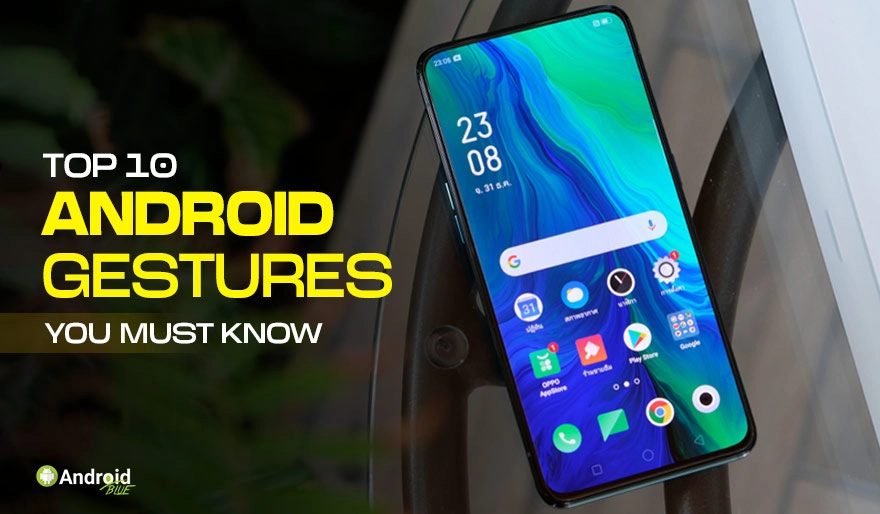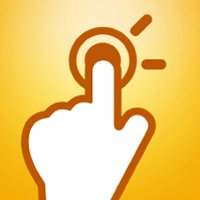Top 10 Android Gestures You Must Know
19 min read What’s the best Android gesture you’ve ever used? With thousands of Android users around the world, our community needs to decide on what Android gestures are most popular. What do we mean by gestures... June 21, 2023 14:19
What’s the best Android gesture you’ve ever used? With thousands of Android users around the world, our community needs to decide on what Android gestures are most popular. What do we mean by gestures? We’re talking about those tap-and-hold actions you perform every day, such as turning your phone’s flashlight on, taking a screenshot, and accessing recent apps. What are your favorites? We’re counting down the top 10 Android gestures that you must know so you can impress your friends, family, and co-workers with your knowledge of this cool technology!
Every time the new version update Android rolls out, we see many different changes including gestures in Android devices. A few years ago, such features could be implemented in smartphones through hardware changes but the technology has evolved to provide you with the best gestures or new features through software updates. The Android update includes a number of new features for your fingers, and we've listed them below. We'll be updating this list as more information becomes available.
If you're a fan of Android, then you probably already have some experience with gesture-based navigation in the stock operating system. But if not, then here's what you should know about them:
1) Swipe Up
Android’s back button has undergone a bit of an identity crisis lately. With some devices (like Samsung’s Galaxy S6) removing it completely, others integrating it into a multitasking button, and still others bringing it back on-screen, figuring out how to go back in an app can be tricky. Thankfully, Google’s come up with an easy solution for us: swipe up. Yep, that's all you need to do: swipe up from your home screen to reveal a hidden menu that'll take you back where you need to go. It works everywhere from Gmail to Maps—but not in every app, unfortunately. To make sure it's enabled, head to Settings > System > Apps & Notifications > App Info and scroll down until you see Recent. Make sure that option is set to Show 'Swipe Up' Button or Show 'Swipe Up' Button at top of the screen. If you don't see those options, try restarting your phone; sometimes apps get stuck and prevent gestures from appearing properly.
2) Swipe Down
This gesture is similar to hitting your phone's drop-down menu. When you swipe down on your screen, you'll be shown a series of shortcuts that are relevant to what you're doing at that moment, like creating a new email or texting someone. If there's a link on a website that you want to see again later, just tap and hold it and then choose to Add to Home Screen. From now on, you can access it by swiping up from the bottom of your screen and accessing your home screens. This gesture takes time to get used to (at least for me).
But once you get it down pat, I think it could be one of my favorite gestures for phones with small screens. It makes it much easier to navigate back and forth between all those links and apps I want easy access to.
Most Android devices have a touch-sensitive panel at the bottom of their displays, which is where Google has placed its quick settings panel. A swipe down reveals a set of buttons that offer quick access to things like WiFi, Bluetooth, and Airplane Mode—basically, everything you’d need in an emergency situation when you can’t pull out your owner’s manual because Uncle Ed borrowed your phone during Thanksgiving dinner. For some devices running Android 5 Lollipop, swiping left-to-right brings up Google Now Cards related to whatever you're looking at on-screen—like directions if you look up directions somewhere online via Chrome browser.
3) Double Tap
Double tapping is an easy way to zoom in and out of images, maps, websites, and emails. If you don’t have a pinching gesture on your device (and many modern Android devices don’t), double-tapping is also a good alternative. It works much like pinch-to-zoom: double tap on your screen to quickly zoom in or out of whatever it is you’re looking at. To try it out, open up any picture app or email client and click on an image or message.
Now double tap once and watch as it zooms into full view. Then try double-tapping again; if you, do it correctly, you should be able to see a few lines of text previewing the next information in your email or image. This might seem counterintuitive when you think about zooming – shouldn’t doing that make things smaller? – but when you really get down to it, making something bigger is just reducing its size by a factor of two.
As far as Android gestures go, there are no hard and fast rules for how long to hold your finger on something for things to work; in general, just give your actions some time before deciding that they aren’t working and doing something else.
4) Pull Down Notification Panel
This can be done by swiping from the top of your device. Once you have pulled down, you will see any alerts or notifications. To view them in more detail, simply tap on them. From here, you can swipe to dismiss any unwanted alerts or touch and hold to launch that specific app. This gesture can also be used in conjunction with other gestures. For example, if you are browsing through a website but wish to return to your previous page, simply pull down from the top of your screen and hit Back/Back (depending on what browser you're using). If for some reason you are unable to access your notification panel at all, long press on a blank space of your home screen and drag downwards until it unlocks it for you.
5) Home Button Assist
Google's latest Android update, comes with an awesome new feature called Home Button Assist. This nifty tool gives you three different ways to access your home screen depending on how many times you tap it within a span of time: twice in under a second and once again within four seconds invokes Google Now; three times in under four seconds and one more time after that will open up your recent apps list. The best part is that these options are customizable, so if you want to use them as shortcuts to something else, just head over to Settings > Accessibility > Home Button Assist and select what works for you. For example, I prefer opening my recent apps rather than launching Google Now because I don't need or use it much.
6) Two Fingers Screenshot
If you have a smartphone running Google’s mobile operating system, you know about tapping and holding to take a screenshot. But as of last year, you can also take screenshots by placing two fingers on your screen and swiping them together. It takes a few tries to get used to it but once you master it, it’s way faster than using a button. More gestures are always welcome in my opinion!
7) App Shortcuts
With App Shortcuts, you can quickly jump to specific parts of an app. For example, on Instagram, you can swipe up from a photo or video to see who it’s been shared with or who’s liked it. This is a big time-saver because it saves you from having to go through multiple steps in order to get what you want. App shortcuts were first introduced in Marshmallow and have since been updated for Oreo. The best part? They work on basically any phone running Nougat (Android 7) or higher! There are more great shortcuts that I'll show you how to use later in my list of must-know gestures—but here's a quick peek at some of my favorites
8) Show/Hide Status Bar
If you’re on a call or watching a video, you don’t necessarily want your navigation bar distracting from what you’re doing. That’s where Show/Hide Status Bar comes in. Just like it sounds, tapping on it will hide your status bar, so you can see more of whatever you were watching or working on. As soon as you tap it again to make it reappear, everything goes back to normal. If you happen to have block notifications while using full-screen apps enabled (which we highly recommend), Show/Hide Status Bar will also hide that notification area so your content is truly unobstructed. Perfect for games or videos!
9) Overview Mode on Pixel Launcher (Home Screen Replacement)
Google introduced a new feature called Overview that lets you access recent apps via a 3D carousel (it's faster than swiping through your full app drawer). While it may seem like a minor change, getting rid of that extra step makes multitasking much easier. Another useful gesture is being able to quickly jump into Google Now by swiping down on your home screen and accessing app info by holding down on an icon (similar to iOS' 3D Touch). To make these even better, you can enable two gestures in developer options: swipe up to return to your home screen, and swipe up and hold for Quick Search Box—which basically replaces using Google Now. These are handy features for anyone who uses their phone or tablet more than a few times a day.
10) Shake It Up!
When you don’t have a specific gesture in mind, try shaking your phone to bring up Google Now (and any other cards that might be available). This one is particularly useful when you’re using headphones or earbuds, as it allows you to quickly activate your voice assistant without having to take them out. This one may not seem like much, but once you try it, you won’t want to use your phone any other way. Also—weirdly enough—it’s even more fun with rear-facing cameras.
Extras
FOCUS – The FOCUS gesture is used for quick access to your most commonly used apps and settings. When using this gesture, you can quickly switch between the home screens of your favorite applications or change your current app by swiping down from the top of the screen. You can also swipe up from the bottom of the screen to launch other apps. Swipe left/right – This gesture lets you quickly scroll through your recent apps and settings. It works best when you are scrolling horizontally, but it will work fine if you use the right side of the screen as well.
SCROLL – This gesture lets you quickly scroll through your recent apps and settings. It works best when you are scrolling horizontally, but it will work fine if you use the right side of the screen as well. Double-tap to wake – This gesture wakes the device automatically when you double-tap the power button. If you want to turn off the phone while it's asleep, then this is the way to do it.
WAKE UP – This gesture wakes the device automatically when you double-tap the power button. If you want to turn off the phone while it's asleep, then this is the way to do it. Long press – This gesture allows you to open certain application windows without having to unlock the device first. For example, you could launch Google Now directly by long-pressing the Home button.
VOLUME – This gesture turns on the display. Volume rocker up/down – These two gestures let you adjust the volume level.
UNLOCK – These two gestures let you adjust the volume level. Home key – This gesture opens the Home screen. This gesture enables you to scan your fingerprint to unlock the device. Touch ID – This gesture provides an additional layer of security that requires you to enter your password before unlocking the device.
Final Thoughts
So there you go! We hope these tips help you get started with Android gestures. What do you think? Do you prefer finger gestures over long presses or vice versa? Let us know in the comments below!
User Comments (0)
Popular Apps









